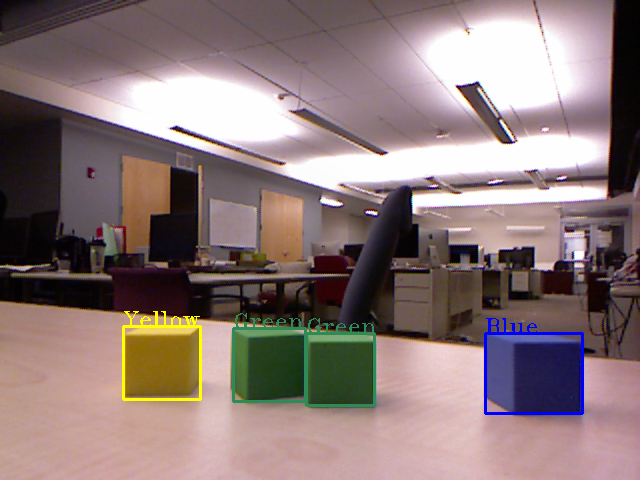Getting 3D points from pointcloud to show objects positions
Hardware: Kinect V1`` Software: Ubuntu 16.04, cv2, python
Hello, Currently in my project I have used used openCV to do color based object detection. My next step in my project is to find the coordinates (x,y,z) in mm of these objects to pass over to another program that uses a robotic arm. An interface would be used as well to request the coordinates of the objects. Say if the user wants to pick up all green objects then the program will return the coordinates of only the green objects. The robotic arm will used the coordinates to pick up the colored object. The problem I am running into is finding how to get these coordinates using the kinectV1. Could I use the get_depth() somehow to get the xyz coordinates? I do not know how to use the point cloud to get coordinates as I have seen that is an option but I could not find any examples with python. Also could I take a picture of the images to get the coordinates of the objects? Any advice would be appreciated. Attached is a picture of my results and my code for your reference. Thank you
Edit: I found this repository https://github.com/amiller/libfreenec... In the calibkinect.py there is code that helps with getting the xyz coordinates from the point cloud. After playing with this code a while I noticed that the image has to be refreshed otherwise the xyz matrix will stay the same. I am just having trouble understanding how can I integrate this with my code.

import cv2
import numpy as np
import freenect
#function to get RGB image from kinect
def get_video():
array,_ = freenect.sync_get_video()
array = cv2.cvtColor(array,cv2.COLOR_RGB2BGR)
return array
#function to get depth image from kinect
def get_depth():
array,_ = freenect.sync_get_depth()
array = array.astype(np.uint8)
return array
if __name__ == "__main__":
while True:
#get a frame from RGB kinect camera
frame = get_video()
#_, frame = cap.read()
#get a frame from depth sensor
#depth = get_depth()
hsv = cv2.cvtColor(frame, cv2.COLOR_BGR2HSV)
#Create kernel to use in filter
kernel = np.ones((5, 5), np.uint8)
#list yellow range
lower_yellow = np.array([15, 60, 30])
upper_yellow = np.array([30, 255, 255 ])
#Create filter for yellow
yellow_mask = cv2.inRange(hsv, lower_yellow, upper_yellow) # Threshold the HSV image to get only yellow colors
opening_y = cv2.morphologyEx(yellow_mask, cv2.MORPH_OPEN, kernel, iterations = 1) #Use morphology open to rid of false pos and false neg (noise)
result_y = cv2.bitwise_and(frame, frame, mask = opening_y) #bitwise and the opening filter with the original frame
#list green range
lower_green = np.array([45, 45, 10])
upper_green = np.array([100, 255, 255])
#Create filter for green
green_mask = cv2.inRange(hsv, lower_green, upper_green)
opening_g = cv2.morphologyEx(green_mask, cv2.MORPH_OPEN, kernel, iterations = 1)
result_g = cv2.bitwise_and(frame, frame, mask = opening_g)
#list blue range
lower_blue = np.array([110, 70, 30])
upper_blue = np.array([130, 255, 255])
#Create filter for blue
blue_mask = cv2.inRange(hsv, lower_blue, upper_blue)
opening_b = cv2.morphologyEx(blue_mask, cv2 ...
